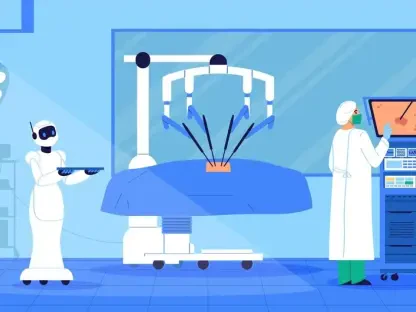The integration of artificial intelligence (AI) into the healthcare industry is revolutionizing the way medical services are delivered, particularly in underserved rural areas. This transformation was the focal point of the inaugural Think Health: AI for Healthy Communities conference held in Bentonville, Arkansas. Despite challenging weather conditions, over 200 attendees, including national leaders in healthcare, technology, education, and policymaking, gathered to explore AI’s potential in enhancing healthcare access and quality in rural regions.
The Promise of AI in Healthcare
Enhancing Communication and Patient Interaction
Jonathan Chen, assistant professor of medicine and biomedical data science at Stanford Medicine, opened the conference with a compelling demonstration of AI’s capabilities. Using an AI-generated avatar, Chen shared how AI has improved his medical practice, particularly in refining his communication skills with patients and their families. By allowing him to rehearse difficult conversations in a low-stakes environment, AI has enabled Chen to enhance his patient interactions significantly. This practice underscores the broader potential of AI in improving healthcare delivery by fostering better communication and understanding between healthcare providers and patients.
Chen’s use of an AI-generated avatar to deliver his opening remarks served as a powerful illustration of how technology can bridge gaps in communication. By practicing challenging high-stakes conversations in a controlled setting, healthcare professionals can approach these critical interactions with greater confidence and competence. This evolution in communication skills is particularly valuable in rural areas where resources and support systems may be limited, and effective patient-provider relationships are crucial. Furthermore, Chen referenced a colleague’s assertion that those who adeptly integrate AI into their practices could potentially replace those who do not, highlighting the increasing importance of AI proficiency in modern medical practice.
Addressing Rural Healthcare Challenges
The panel discussion, moderated by Sharmila Makhija, founding dean and CEO of the Alice L. Walton School of Medicine (AWSOM), delved into the specific challenges faced by rural healthcare systems. Panelists, including Natasha Bray, Steve Mackin, and Yogi Hernandez Suarez, highlighted critical issues such as low life expectancy in rural areas like Stilwell, Oklahoma. Bray emphasized the importance of training physicians to serve in these communities and acknowledged the role of social determinants like education, food access, and internet connectivity in shaping health outcomes. The discussion underscored the need for a multifaceted approach to address these challenges effectively.
Bray’s insights into the stark life expectancy disparities underscored the urgency of addressing rural healthcare inequities. She highlighted that efforts to train physicians specifically for rural service are critical but not sufficient in isolation. Addressing broader social determinants, such as ensuring access to quality education, nutritious food, and reliable internet, are equally crucial. This holistic approach aligns with the conference’s overarching theme of leveraging AI and technology to not only improve medical care but also to tackle the socioeconomic factors that significantly influence health outcomes. The discussion revealed a consensus on the necessity of integrated solutions that combine medical training, technological innovation, and community support to effectively serve rural populations.
Technological Innovations in Rural Healthcare
Virtual Hospitals and Collaborative Care Models
Steve Mackin, president and CEO of Mercy, shared insights into Mercy’s strategic implementation of a virtual hospital in 2014. This initiative aimed to bridge the healthcare availability gap in rural communities by leveraging technology-enabled care models. Through integrated team-based care, rural facilities like the one in Berryville, Arkansas, can collaborate with urban counterparts in St. Louis. This collaboration facilitates critical decisions about patient transfers and treatments locally, reducing the need for relocation to urban hospitals. Mackin’s remarks highlighted the growing acceptance of technology among both new and seasoned physicians, driving continuous investment in rural healthcare.
Mackin elaborated on how Mercy’s virtual hospital model supports rural healthcare systems by enabling real-time collaboration between rural and urban healthcare providers. This model empowers local healthcare staff to make informed decisions and manage complex cases with the support of specialists from urban centers, ultimately enhancing patient care and reducing unnecessary patient transfers. The technology-driven approach also allows for more efficient use of resources, ensuring that rural communities receive timely and appropriate medical attention. Mackin’s emphasis on the willingness of healthcare professionals to embrace technological advancements underscored the importance of fostering a culture of innovation within the medical field to sustain and expand such initiatives.
AI Algorithms and Operational Efficiencies
Mercy’s deployment of over 125 AI algorithms has significantly enhanced patient care and operational efficiencies. These algorithms have improved patient transfers from emergency rooms to inpatient care settings, demonstrating the practical applications of AI in healthcare. By streamlining processes and enabling more informed decision-making, AI is helping to optimize healthcare delivery in rural areas. This technological advancement is crucial in addressing the unique challenges faced by rural healthcare systems and improving overall patient outcomes.
The integration of AI algorithms within Mercy’s healthcare framework showcases the tangible benefits of AI in streamlining operations and enhancing patient care. These algorithms assist in diagnosing conditions, predicting patient needs, and managing patient flow, reducing bottlenecks in emergency and inpatient care settings. The ability to analyze large datasets and provide actionable insights enables healthcare providers to anticipate complications and allocate resources more effectively. This efficiency not only improves patient outcomes but also maximizes the reach and impact of medical services in rural areas where healthcare resources are often scarce. AI’s role in transforming operational workflows contributes to creating more resilient and responsive healthcare systems capable of meeting the demands of rural communities.
The Evolving Role of Healthcare Providers
From Individual to Community Care
Yogi Hernandez Suarez emphasized the need for a shift from traditional “numerator doctors,” who focus on individual patient treatment, to “denominator doctors,” who cater to broader populations and communities. This approach advocates for integrating patient outcomes into the healthcare system, promoting holistic care over isolated treatments. Suarez highlighted the evolving criteria for medical school admissions, which now prioritize diverse values and capabilities. This shift aims to cultivate a new generation of physicians prepared to take risks and drive innovation in the field, ultimately improving healthcare access and quality in rural areas.
Suarez’s call for a transformation in medical practice and education resonates with the conference’s theme of holistic and community-oriented care. By fostering a cadre of healthcare providers who think beyond individual patient encounters to consider broader community health needs, the healthcare system can better address the intricate challenges of rural healthcare. Emphasizing diverse values in medical training facilitates the development of empathetic, innovative, and adaptable physicians who are well-equipped to serve underserved populations. This paradigm shift supports the creation of health systems that are not only responsive to immediate medical issues but also proactive in fostering long-term community health and well-being.
Medication Adherence and Patient Partnerships
A significant portion of the discussion revolved around medication adherence, with Suarez pointing out that nearly two-thirds of patients fail to follow prescribed medication regimens. This issue underscores the necessity of building patient partnerships grounded in trust and health literacy. AI can play a crucial role in providing insights into patient behaviors and challenges, enabling healthcare providers to tailor their approaches to individual patient needs. By aligning medical advice with the socio-economic realities of patients, AI can enhance overall health outcomes and community well-being.
Addressing medication adherence through AI-driven insights highlights the potential for personalized healthcare solutions that resonate with patients’ lived experiences. By utilizing AI to monitor and analyze patient behavior, healthcare providers can identify patterns and obstacles that prevent adherence to treatment plans. This data-driven approach enables the formulation of more effective, individualized strategies that consider socio-economic factors influencing patient compliance. The development of trust-based partnerships between patients and providers, facilitated by AI, can lead to improved health literacy and shared decision-making. This engagement is crucial in empowering patients and enhancing their commitment to prescribed regimens, thereby fostering better health outcomes in rural communities.
Collaborative Efforts and Future Directions
Strategic Partnerships and Innovative Models
Walter Harris, president of health strategy and delivery at Heartland Whole Health Institute, highlighted the successful partnership between the Alice L. Walton Foundation, Heartland Whole Health Institute, and Mercy. This collaboration aims to emulate Mercy’s virtual model and bring about significant advancements in healthcare delivery through strategic AI integration. Harris emphasized that AI should augment rather than replace human roles, enhancing patient experiences, reducing costs, and easing the burden on healthcare providers. The partnership reflects a shared innovative spirit and a commitment to improving healthcare access in rural communities.
Harris also addressed the importance of fostering innovative partnerships to replicate successful models like Mercy’s virtual hospital. The collaboration between major health institutions and foundations aims to scale these advancements, ensuring more communities benefit from strategic AI integration. By combining resources, expertise, and technological capabilities, these collaborative efforts strive to create sustainable, scalable healthcare solutions tailored to the unique needs of rural populations. The overarching goal is to ensure that AI’s transformative potential extends beyond individual initiatives, promoting widespread improvements in healthcare delivery and accessibility across rural America.
Balancing Technology and Human Oversight
Artificial intelligence (AI) is transforming the healthcare industry, particularly in underserved rural areas, by revolutionizing the delivery of medical services. This significant change was the central theme of the first-ever Think Health: AI for Healthy Communities conference, which took place in Bentonville, Arkansas. Despite the challenging weather conditions, the event successfully brought together over 200 attendees, including prominent national leaders in healthcare, technology, education, and policymaking.
The conference focused on exploring AI’s potential to improve healthcare access and quality in rural regions where resources are often limited. By leveraging AI, healthcare providers can offer more efficient and accurate diagnoses, predict outbreaks, and personalize treatment plans. This technology is particularly valuable in rural settings, where medical facilities are often spread out and understaffed. The event highlighted how AI could bridge gaps in healthcare service delivery, ultimately leading to healthier and more resilient rural communities.









